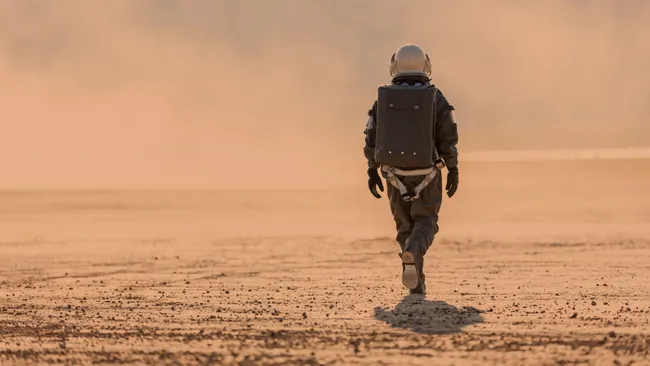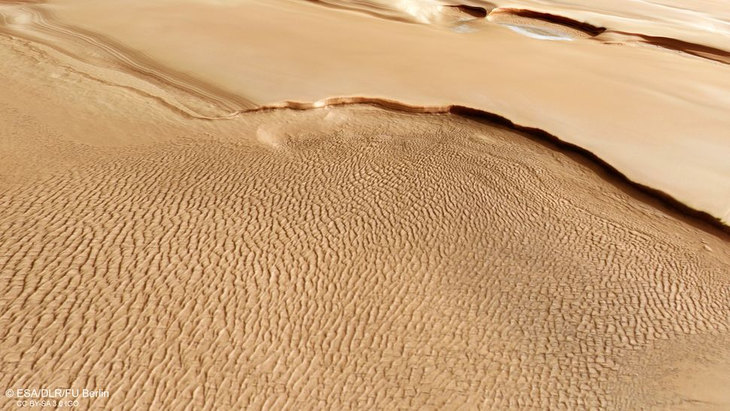 |
| (Photo source: Nisian Hughes/Getty Images) |
Anyone walking on Mars would likely explore only a small portion of the planet's surface. But without oceans or other sources of water, could an astronaut walk around the Red Planet ? How long would it take to walk around Mars?
Not surprisingly, a long time – although it's hard to say exactly how long. If the astronaut could move continuously at a walking pace, it would be a simple calculation.
“We basically need two parameters,” said Erdal Yigit, an associate professor of physics and astronomy at George Mason University who studies planetary atmospheres. Those parameters are the astronaut’s velocity (speed and direction) and the distance they will travel.
If a person walked along the Martian equator, they would have to walk about 13,300 miles (21,400 kilometers) to circle the planet. Going around Mars via its poles would take about 100 miles (160 kilometers), but the extreme cold would pose an even greater challenge than the harsh conditions on the rest of the planet, Yigit said.
Yigit says the person would be traveling at about 3.1 mph (5 km/h), which is also the average walking speed on Earth, along the equator. Although Mars' gravity is reduced (about 40% of Earth's), Yigit suspects a person's walking speed would be much different on Mars. Like any hiker on Earth, the person would likely be carrying a large amount of supplies — such as oxygen, water, and food — and would be wearing a heavy spacesuit.
If someone were to walk around Mars continuously at that speed, the math would be simple: Just divide the distance by the speed. That means it would take about 4,290 hours. A Martian day is about 24.7 hours (called a sol), so it would take about 174 sols to walk around Mars continuously. That’s more than a quarter of a Martian year, or 668.6 sols.
 |
| This oblique perspective view of the area around Mars' north pole was created from a digital terrain model and the color channels and nadirs of the High Resolution Stereo Camera on the European Space Agency's Mars Express orbiter. It shows a vast expanse of rippling sand dunes in the foreground; kilometer-high icy cliffs and cliffs beyond these dunes; and finer layers of dust and ice in the distance. (Image credit: ESA/DLR/FU Berlin) |
Of course, no one could do that trip nonstop—on Mars, Earth, or anywhere else. Even if someone could carry enough oxygen, water, and food with them and eat as they walked, they would still need to stop to sleep. Assuming astronauts sleep about eight hours a night, that adds up to about 56 sols. If someone stopped for four or five hours every sol to eat, rest, change clothes, shower, and set up and clean up some kind of campsite, that would add another 30 or 35 sols, depending on how long they stopped.
In general, a more realistic estimate might be at least 265 sols, about 40 percent of a Martian year. But that calculation doesn’t take into account potential obstacles, such as rugged terrain. Mars has many mountains, some of which are taller than any on Earth, as well as valleys, craters, and many other geological features that make it difficult to navigate.
Of course, it’s unlikely that anyone will be walking around Mars anytime soon. Humans have walked around Earth, although they can’t actually walk or run around it because of the oceans. But humans have only walked on a small part of the Moon, despite traveling there many times. And walking so far and for so long on Mars would pose a host of logistical problems, like carrying enough food, water, and oxygen, and protecting humans from the dangerous effects of radiation.
While it's unlikely humans will ever circumnavigate the entire Red Planet, sending astronauts to the surface still has many advantages over rovers, Yigit said.
Source

































































































![[Infographic] In 2025, 47 products will achieve national OCOP](https://vphoto.vietnam.vn/thumb/402x226/vietnam/resource/IMAGE/2025/7/16/5d672398b0744db3ab920e05db8e5b7d)





Comment (0)